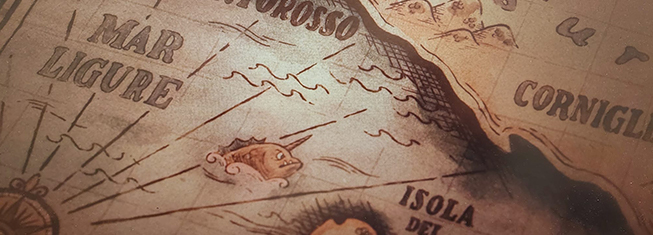Ligurian Places in the Film: Luca

There’s a lot of Liguria in the Disney-Pixar film, Luca, let’s discover them all!
“Luca,” the Disney-Pixar film, available on the Disney+ platform, is set entirely in Liguria. The Genoese director, Enrico Casarosa, filled the film with Ligurian references, both obvious and hidden. Images, places, situations, newspapers, and real or fictional streets that has circulated worldwide. Here’s what we’ve recognised.
Liguria
Portorosso being in Liguria is evident: one of the first shots is a map of the region, where the name of the fictional village is located next to Corniglia, one of the Cinque Terre towns. The Cinque Terre itself is the most obvious iconographic reference, both when Luca and Alberto look out from the Tower (one of the dozens of watchtowers against the Saracens that dot the Ligurian and Tyrrhenian coasts) and when the train to Genoa takes Giulia and Luca to the city, with a panorama of the coast and the unmistakable silhouette of the Portofino area. Even the “Isola del Mare” in front of Portorosso, where Alberto lives, closely resembles Tino – the islet with Palmaria and Tinetto that determines the Gulf of Poets. The small Portorosso resembles Vernazza, with its seafront square, incorporating a piece of Camogli (the arched passage toward the pier where Ercole arrives). Alleys, cobblestones, colours, and vineyards are inspired from all over Liguria, while typical of the Genoese coast is the small grey pebble beach where the two sea monsters come ashore.
Easter Eggs and References
Easter eggs, literally Easter eggs, are audio or video content of any kind that the director decides to hide in the film. In “Luca,” some are quite evident, especially in the toponymy and names of shops in Portorosso. The main square is dedicated to Italo Calvino, a native of Sanremo, just like Imperia’s Edmondo De Amicis, who has a plaque on a creuza. “Via Corniglia” is briefly visible but present. Another street references “Revello,” the famous bakery in Camogli, and, of course, “Via Piaggio” couldn’t be missed – this is the street where director Enrico Casarosa lived (besides being the road named after the Ligurian entrepreneur who founded Piaggio, the Vespa brand).
But it’s mainly the shops that provide references that non-Ligurians might not catch: Pittaluga (bar) and Repetto (Grocery) are two typical Genoese surnames, San Giorgio (dairy) is the patron saint of Genoa. And what about the signs of the mechanic selling Vespas? “Gomme Ravatti” (in dialect, ravatto means both trinket and a person who is a bit ugly or not in good health) and “Paciugo” (a mess, but also a flavour of ice cream).
The Food
“The most Genoese thing I managed to include is potatoes and green beans in the trenette al pesto,” director Casarosa declared. And pesto pasta is indeed a main character in “Luca.”
But our attentive eye also found other delights. The Da Marina trattoria, in the pasta-making scene, displays a faded menu board: you can read “trofie al pesto” and “baccalà” (perhaps stockfish would have been better). The focaccia shop in Portorosso produces – according to the sign – Focaccia, farinata, and cheese focaccia. Finally, did anyone notice what Ercole’s motorboat is called? Exactly, “Focaccia.”
Genoa
No spoilers, but the story ends in Genoa, featuring – along with the events in the lives of Luca, Alberto, and Giulia after the film – drawings accompanying the credits. There is a beautiful panorama from Castelletto, and landmarks like the elevator, the bell tower of the Cathedral, and of course, the Lantern are recognisable. The Lantern emerges from the window while the protagonists have breakfast (coffee and focaccia), and finally, for the truly attentive eyes, canestrelli – a typical Ligurian sweet – make an appearance. We also noticed a newspaper (“Il Tigullio”), pairing with “La tribuna ligure” that appears in the film. The last frame is for pesto, just before the end (watch the film until the last seconds): here are the ingredients, from basil to garlic, to cheese. And its majesty, the mortar.
Have you found any others?


